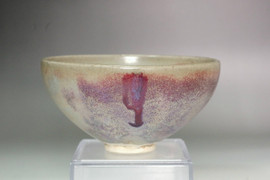Fine Early Qing Jun ware Lobed Bowl and Dish, 17C, China #5302
- SKU:
- 5302
- Shipping:
- Calculated at Checkout
bowl
width: 10cm (3 15⁄16in)
hight: 5cm (1 31⁄32in)
weight:172g
condition: very small chip in rim and cracks (or firing fault) in bottom
plate
width: 13cm (5 1⁄8in)
weight: 168g
total weight: 340g
This piece is a matching bowl and dish set in the Jun ware, believed to have been produced during the early Qing dynasty, between the Shunzhi and Kangxi reigns in the mid-17th century. Following the revivalist aesthetic trends of the late Ming period, the new Qing dynasty sought to assert its cultural legitimacy by reviving the classical ceramic traditions of earlier dynasties, particularly those of the Song. The Kangxi era, in particular, was a time of technical innovation, during which a wide range of glaze effects were explored. Works such as this—featuring a clear bluish glaze with flowing streaks of purplish-red (yaobian)—epitomize the refined taste and high level of kiln control that characterized this period.
The lobed form of the vessel, imitating the petals of a flower, departs from the more restrained shapes of genuine Song Jun ware and reflects the early Qing interest in naturalistic forms and decorative elegance. The glaze itself is of particular note: the translucent pale blue base merges seamlessly with the fluid purple streaks, evoking the beauty of a painted landscape. This effect was achieved not by chance, but through precise control of oxidation firing and glaze thickness—hallmarks of early Qing ceramic technology. The purplish-red glaze appears to have been applied with intentionality, creating what may be termed a "calculated yaobian," in contrast to the spontaneous and unpredictable patterns found in original Song pieces.
Altogether, this work exemplifies the confluence of revivalist culture and technical mastery in the early Qing period. It stands as a fine example of refined craftsmanship and aesthetic sophistication, likely intended for a literati or elite clientele who valued both antiquity and innovation.













